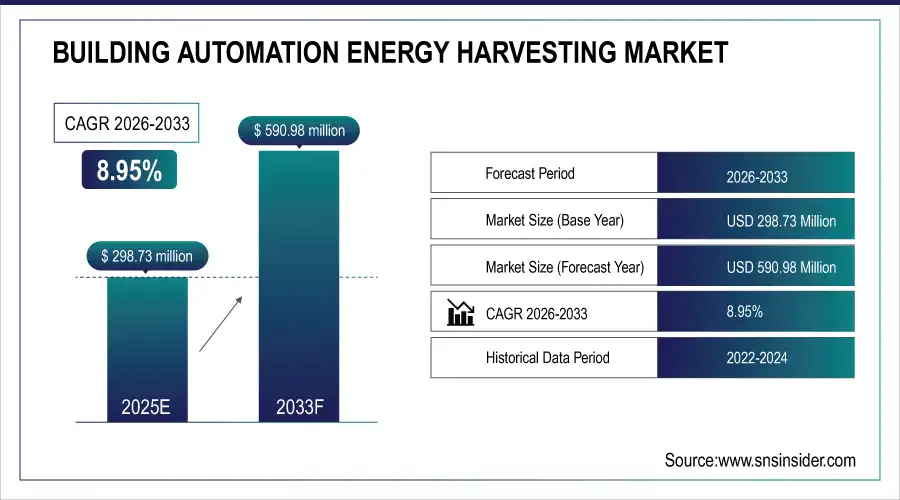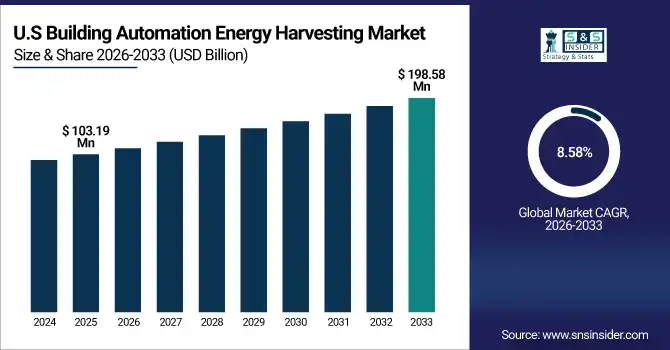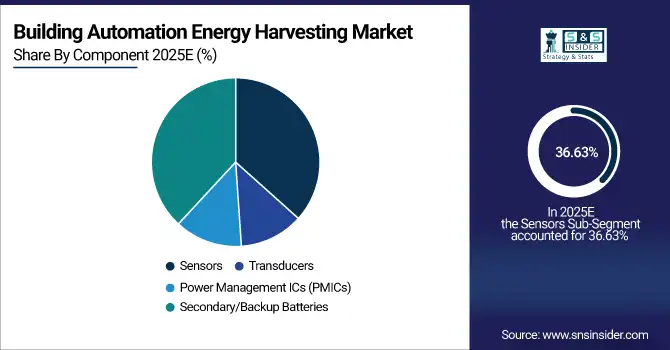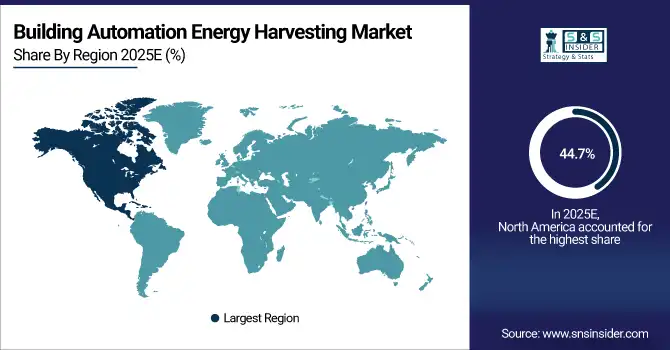Building Automation Energy Harvesting Market Report Scope & Overview:
The Building Automation Energy Harvesting Market size was valued at USD 298.73 Million in 2025E and is projected to reach USD 590.98 Million by 2033, growing at a CAGR of 8.95% during 2026-2033.

To Get more information On Building Automation Energy Harvesting Market - Request Free Sample Report
The Building Automation Energy Harvesting Market is growing due to increasing adoption of smart buildings, demand for energy-efficient solutions, and the rising need to reduce dependency on wired power and batteries. Expanding IoT integration in building systems such as HVAC, lighting, and security is driving the use of self-powered wireless sensors. Advancements in solar, vibration, thermal, and RF energy harvesting technologies are enhancing system efficiency and reliability. Additionally, sustainability initiatives and government regulations promoting green buildings are further accelerating market expansion.
The EnOcean Alliance includes over 400 members as of 2024, working to develop interoperable, maintenance-free energy harvesting solutions for buildings globally.
Key Building Automation Energy Harvesting Market Trends
-
Growing adoption of smart building technologies integrating IoT-enabled wireless sensors for HVAC, lighting, and security systems.
-
Increased focus on energy-efficient infrastructure supported by advancements in solar, vibration, thermal, and RF energy harvesting technologies.
-
Rising implementation of sustainability initiatives and government regulations driving eco-friendly building automation solutions.
-
Expansion of smart city projects and urbanization fueling demand for scalable, self-powered automation systems.
-
Innovation in energy harvesting materials and power management technologies enabling improved efficiency and reduced maintenance costs.
The U.S. Building Automation Energy Harvesting Market size was valued at USD 103.19 Million in 2025E and is projected to reach USD 198.58 Million by 2033, growing at a CAGR of 8.58% during 2026-2033. The U.S. Building Automation Energy Harvesting Market is growing due to increasing smart building adoption, rising demand for energy-efficient solutions, advancements in IoT-enabled wireless sensors, and strong government initiatives promoting sustainable, self-powered building automation systems.

Building Automation Energy Harvesting Market Growth Drivers:
Smart Building Adoption and Advanced Energy Harvesting Technologies Drive Global Market Growth
The global Building Automation Energy Harvesting market is primarily driven by the increasing adoption of smart building technologies and the growing need for energy-efficient infrastructure. Rising integration of IoT-enabled wireless sensors in HVAC, lighting, and security systems is fueling demand, as these systems reduce wiring costs, enhance operational efficiency, and minimize maintenance needs. Advancements in solar, vibration, thermal, and RF energy harvesting technologies are further enabling reliable, self-powered building automation solutions. Additionally, stringent government regulations and sustainability initiatives worldwide are encouraging building owners and developers to adopt eco-friendly, energy-harvesting systems.
In 2024, over 200 energy storage-related bills were introduced across 34 U.S. states, with more than 40 enacted, emphasizing the importance of energy storage solutions in building automation.
Building Automation Energy Harvesting Market Restraints:
-
Technical Limitations and Integration Challenges Restrain Building Automation Energy Harvesting Market Growth
The global Building Automation Energy Harvesting market faces restraints from technical limitations such as low energy conversion efficiency and intermittent power generation, which affect system reliability. Integration challenges with existing building infrastructure and compatibility issues across different devices can slow adoption. Additionally, the lack of standardized protocols and skilled workforce for installation and maintenance may hinder widespread deployment, particularly in retrofitting older buildings.
Building Automation Energy Harvesting Market Opportunities:
-
Expanding Applications and Technological Advancements Driving Future Growth in Building Automation Energy Harvesting
The market presents significant opportunities in expanding applications across commercial, industrial, and residential sectors. Rapid urbanization, coupled with the growth of smart cities and green building projects, is creating demand for scalable, self-powered automation solutions. Further, advancements in energy harvesting materials and power management technologies offer opportunities for innovation, cost reduction, and enhanced system efficiency, positioning the market for substantial growth in the coming decade.
In 2024, over 2,400 smart city projects were underway globally, with Asia and Europe leading deployments of intelligent building systems that integrate energy harvesting solutions.
Building Automation Energy Harvesting Market Segment Analysis
-
By Energy Source, Solar Energy dominated with 41.48% in 2025E, and Vibration & Kinetic Energy is expected to grow at the fastest CAGR of 9.69% from 2026 to 2033.
-
By Building Systems, HVAC (Heating, Ventilation, and Air Conditioning) dominated with 39.42% in 2025E, and Lighting is expected to grow at the fastest CAGR of 9.65% from 2026 to 2033.
-
By Application, Powering Wireless Sensors dominated with 42.56% in 2025E, and Operating Automated Controls is expected to grow at the fastest CAGR of 9.63% from 2026 to 2033.
-
By Component, Sensors dominated with 36.63% in 2025E, and Transducers is expected to grow at the fastest CAGR of 9.59% from 2026 to 2033.
By Energy Source, Solar Energy Leads 2025 While Vibration and Kinetic Energy Drive Future Building Automation Growth
In 2025E, Solar Energy dominated the Building Automation Energy Harvesting market due to its widespread use in powering wireless sensors, lighting systems, and HVAC controls, driven by advancements in photovoltaic technology and strong adoption in smart buildings. From 2026 to 2033, Vibration & Kinetic Energy is expected to grow the fastest, supported by rising deployment of motion-powered sensors in commercial, industrial, and residential buildings, and innovations in compact, high-efficiency transducers for self-powered automation systems.
By Building Systems, HVAC Leads 2025 While Lighting Drives Rapid Growth in Building Automation Energy Harvesting Market
In 2025E, HVAC (Heating, Ventilation, and Air Conditioning) dominated the Building Automation Energy Harvesting market due to its extensive use of wireless sensors and automation controls that improve energy efficiency and reduce maintenance. From 2026 to 2033, Lighting is expected to grow the fastest, driven by the rising adoption of smart lighting systems in commercial and residential buildings. Advances in solar-powered lighting, wireless control technologies, and demand for energy-efficient solutions are fueling this rapid growth.
By Application, Wireless Sensors Dominate 2025 While Automated Controls Propel Future Building Automation Energy Harvesting Market Growth
In 2025E, Powering Wireless Sensors dominated the Building Automation Energy Harvesting market due to its critical role in enabling self-powered, maintenance-free systems for HVAC, lighting, and security applications. From 2026 to 2033, Operating Automated Controls is expected to grow the fastest, driven by increasing adoption of smart building management systems, IoT integration, and AI-enabled automation. Advances in energy harvesting technologies will further enable reliable, scalable, and efficient automated control solutions across commercial, industrial, and residential sectors.
By Component, Sensors Lead 2025 Growth While Transducers Drive Future Building Automation Energy Harvesting Market Expansion
In 2025E, Sensors dominated the Building Automation Energy Harvesting market due to their widespread use in powering wireless systems for HVAC, lighting, and security, enabling energy efficiency and reduced maintenance. From 2026 to 2033, Transducers are expected to grow the fastest, driven by advancements in vibration, kinetic, thermal, and RF energy harvesting technologies. Increasing demand for compact, high-efficiency transducers in smart building systems will accelerate adoption, supporting scalable, self-powered automation solutions across commercial, industrial, and residential sectors.

Building Automation Energy Harvesting Market Report Analysis
North America Building Automation Energy Harvesting Market Insights
In 2025, North America dominated the Building Automation Energy Harvesting market with 44.7%, driven by advanced smart building infrastructure, high adoption of IoT-enabled systems, and a strong focus on energy efficiency. The region’s leadership is supported by extensive retrofit projects, robust technological innovation, and favorable government policies promoting sustainable building practices. The presence of major industry players and early adoption of wireless energy harvesting solutions in commercial, industrial, and residential sectors further reinforced North America’s dominant position in the global market.

Get Customized Report as per Your Business Requirement - Enquiry Now
U.S. Building Automation Energy Harvesting Market Insights
In 2025, the U.S. dominated the North American Building Automation Energy Harvesting market due to advanced smart building adoption, strong IoT integration, supportive energy efficiency regulations, and significant investments in sustainable infrastructure across commercial, industrial, and residential sectors.
Asia Pacific Building Automation Energy Harvesting Market Insights
From 2026 to 2033, Asia Pacific is expected to grow the fastest in the Building Automation Energy Harvesting market, with a projected CAGR of 10.02%, driven by rapid urbanization, expanding smart city initiatives, and strong investments in green building projects. Rising adoption of IoT-enabled automation systems in countries like China, India, and Japan, coupled with supportive government policies and technological advancements in energy harvesting, will fuel significant growth across commercial, industrial, and residential sectors in the region.
China Building Automation Energy Harvesting Market Insights
In Asia Pacific, China dominated the Building Automation Energy Harvesting market due to rapid urbanization, large-scale smart city projects, strong government support for green buildings, and significant investments in IoT-enabled automation systems across commercial, industrial, and residential sectors.
Europe Building Automation Energy Harvesting Market Insights
In 2025, Europe accounted for 21.69% of the Building Automation Energy Harvesting market, driven by strong adoption of energy-efficient building solutions, stringent environmental regulations, and growth in smart city initiatives. Countries such as Germany, France, and the UK are leading the adoption of wireless energy harvesting systems for HVAC, lighting, and security. Supportive government policies, sustainability mandates, and advanced technology integration are further strengthening Europe’s position as a key market for energy harvesting in building automation.
Germany Building Automation Energy Harvesting Market Insights
In Europe, Germany dominated the Building Automation Energy Harvesting market due to strong government regulations on energy efficiency, advanced smart building adoption, significant investments in sustainable infrastructure, and leadership in integrating wireless energy harvesting systems across commercial and industrial buildings.
Latin America (LATAM) and Middle East & Africa (MEA) Building Automation Energy Harvesting Market Insights
In 2025, the Latin America (LATAM) and Middle East & Africa (MEA) Building Automation Energy Harvesting markets showed steady growth, driven by increasing urbanization, infrastructure development, and adoption of smart building technologies. In LATAM, Brazil leads with investments in energy-efficient systems, while MEA growth is driven by sustainability initiatives and smart city projects in the UAE and Saudi Arabia. Supportive government policies, rising IoT integration, and growing awareness of energy efficiency are key factors shaping both regions.
Competitive Landscape for Building Automation Energy Harvesting Market:
ABB is a global leader in electrification, automation, and digital solutions, providing advanced Building Automation Energy Harvesting technologies. The company offers smart building systems integrating energy-efficient HVAC, lighting, and security solutions, leveraging IoT and renewable energy sources to enhance sustainability, reduce energy consumption, and enable self-powered automation in commercial, industrial, and residential sectors.
- In August 2025, ABB signed a Memorandum of Understanding with Paragon Energy Solutions to develop integrated Instrumentation, Control, and Electrification solutions for the U.S. nuclear power industry. This collaboration aims to create a single-vendor solution for both critical and non-critical areas of nuclear facilities.
Advanced Linear Devices, Inc. (ALD) is a U.S.-based semiconductor company specializing in ultra-low-power, precision CMOS analog integrated circuits. Founded in 1985 and headquartered in Sunnyvale, California, ALD serves OEMs across various industries, including industrial control, instrumentation, automotive, medical devices, and telecommunications
- In July 2025, ALD introduced a new Supercapacitor Auto Balancing (SAB) MOSFET that sets a new standard in power management for supercapacitors rated at 3V or higher. This innovation enhances energy efficiency in applications requiring low-loss power and leakage current regulation.
Building Automation Energy Harvesting Market Key Players:
Some of the Building Automation Energy Harvesting Market Companies
- ABB
- Advanced Linear Devices, Inc.
- Cedrat Technologies
- EnOcean GmbH
- Fujitsu Limited
- Honeywell International Inc.
- Kinergizer BV
- Laird Connectivity
- Mide Technology Corporation
- Mouser Electronics, Inc.
- Perpetua Power
- Powercast Corporation
- Renesas Electronics Corporation
- STMicroelectronics NV
- Texas Instruments Incorporated
- ZF Friedrichshafen AG
- Analog Devices Inc.
- Microchip Technology Inc.
- Infineon Technologies AG
- e-peas S.A.
| Report Attributes | Details |
|---|---|
| Market Size in 2025E | USD 298.73 Million |
| Market Size by 2033 | USD 590.98 Million |
| CAGR | CAGR of 8.95% From 2026 to 2033 |
| Base Year | 2025E |
| Forecast Period | 2026-2033 |
| Historical Data | 2022-2024 |
| Report Scope & Coverage | Market Size, Segments Analysis, Competitive Landscape, Regional Analysis, DROC & SWOT Analysis, Forecast Outlook |
| Key Segments | • By Energy Source (Solar Energy, Vibration & Kinetic Energy, Thermal Energy, and Radio Frequency (RF) Energy) • By Building Systems (HVAC (Heating, Ventilation, and Air Conditioning) • By Lighting, Security, and Access Control), Application (Powering Wireless Sensors, Operating Automated Controls, Charging Battery Backups, and Providing Emergency Power) • By Component (Sensors, Transducers, Power Management ICs (PMICs), and Secondary/Backup Batteries) |
| Regional Analysis/Coverage | North America (US, Canada), Europe (Germany, UK, France, Italy, Spain, Russia, Poland, Rest of Europe), Asia Pacific (China, India, Japan, South Korea, Australia, ASEAN Countries, Rest of Asia Pacific), Middle East & Africa (UAE, Saudi Arabia, Qatar, South Africa, Rest of Middle East & Africa), Latin America (Brazil, Argentina, Mexico, Colombia, Rest of Latin America). |
| Company Profiles | ABB, Advanced Linear Devices, Cedrat Technologies, EnOcean GmbH, Fujitsu Limited, Honeywell International, Kinergizer BV, Laird Connectivity, Mide Technology, Mouser Electronics, Perpetua Power, Powercast Corporation, Renesas Electronics, STMicroelectronics, Texas Instruments, ZF Friedrichshafen, Analog Devices, Microchip Technology, Infineon Technologies, e-peas S.A. |

